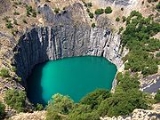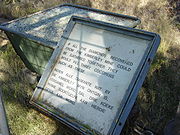
Big Hole
Encyclopedia


Open-pit mining
Open-pit mining or opencast mining refers to a method of extracting rock or minerals from the earth by their removal from an open pit or borrow....
and underground mine in Kimberley, South Africa, and claimed to be the largest hole excavated by hand.
History
The first diamonds here were found on Colesberg Kopje by members of the "Red Cap Party" from ColesbergColesberg
Colesberg is a town with 17,354 inhabitants in the Northern Cape province of South Africa, located on the main road from Cape Town to Johannesburg....
on the farm Vooruitzigt belonging to the De Beers
De Beers
De Beers is a family of companies that dominate the diamond, diamond mining, diamond trading and industrial diamond manufacturing sectors. De Beers is active in every category of industrial diamond mining: open-pit, underground, large-scale alluvial, coastal and deep sea...
brothers. The ensuing scramble for claims led to the place being called New Rush, later renamed Kimberley. From mid-July 1871 to 1914 up to 50,000 miners dug the hole with picks and shovels , yielding 2720 kilograms (5,996.6 lb) of diamond
Diamond
In mineralogy, diamond is an allotrope of carbon, where the carbon atoms are arranged in a variation of the face-centered cubic crystal structure called a diamond lattice. Diamond is less stable than graphite, but the conversion rate from diamond to graphite is negligible at ambient conditions...
s. The Big Hole has a surface of 17 hectares (42 acre) and is 463 metres (1,519 ft) wide. It was excavated to a depth of 240 metres (787.4 ft), but then partially infilled with debris reducing its depth to about 215 metres (705.4 ft). Since then it has accumulated about 40 metres (131.2 ft) of water, leaving 175 metres (574.1 ft) of the hole visible. Once above-ground operations became too dangerous and unproductive, the kimberlite
Kimberlite
Kimberlite is a type of potassic volcanic rock best known for sometimes containing diamonds. It is named after the town of Kimberley in South Africa, where the discovery of an diamond in 1871 spawned a diamond rush, eventually creating the Big Hole....
pipe of the Kimberley Mine was also mined underground by Cecil Rhodes' De Beers company to a depth of 1097 metres (3,599.1 ft).
There is currently an effort in progress to register the Big Hole as a World Heritage Site
World Heritage Site
A UNESCO World Heritage Site is a place that is listed by the UNESCO as of special cultural or physical significance...
.
The Excavation
In 1872, one year after digging started, the population of the camp of diggers grew to around 50,000. As digging progressed, many men met their deaths in mining accidents. The unsanitary conditions, scarcity of water and fresh vegetables as well as the intense heat in the summer, also took their toll. On the 13 March 1888 the leaders of the various mines decided to amalgamate the separate diggings into one big mine and one big company known as De Beers Consolidated Mines Limited, with life governors such as Cecil John RhodesCecil John Rhodes
Cecil John Rhodes PC, DCL was an English-born South African businessman, mining magnate, and politician. He was the founder of the diamond company De Beers, which today markets 40% of the world's rough diamonds and at one time marketed 90%...
, Alfred Beit
Alfred Beit
Alfred Beit was a German, British South African, Jewish gold and diamond magnate, a supporter of British imperialism in Southern Africa and a major donor towards infrastructure development in central and Southern Africa, and to university education and research in several countries.- Life and...
and John Rhodes
John Rhodes
John Rhodes may refer to:* John Rhodes , theatrical figure in London* John Rhodes , British Formula One driver* John Rhodes , British Olympic gold medalist in 1908...
. This massive company further worked on the Big Hole until it came to the depth of 215 metres, with a surface area of about 17 hectares and perimeter of 1.6 kilometres. By 14 August 1914, when over 22 million tons of earth had been excavated, yielding 2,722 kilograms (14,504,566 carats) of diamonds, work on the mine eased after it was considered the largest hand-dug excavation on earth.
Controversy
Due to weathering, the hole has become partly filled with stones and rain, leaving the current remaining depth of 215 metres; as a result there is now some controversy as to whether it still qualifies as the largest hand excavated hole. In 2005, historian Steve Lunderstedt claimed that the largest hand excavated hole is in now at Jagersfontein MineJagersfontein Mine
Jagersfontein Mine is an abandoned open-pit mine in South Africa located close to the town of Jagersfontein and approximately south-west of Bloemfontein. Since it was first established in 1888, two of the ten biggest diamonds ever discovered, the Excelsior and the Reitz , were mined from...
, another old South African diamond mine.
See also
- Kimberlite pipes
- Mir diamond pipe
- Udachnaya pipeUdachnaya pipeUdachnaya pipe is a diamond deposit in the Daldyn-Alakit kimberlite field in Sakha Republic, Russia. It is an open-pit mine, and is located just outside the Arctic circle at . Udachnaya was discovered on June 15, 1955, just two days after the discovery of the diamond pipe Mir by Soviet...

